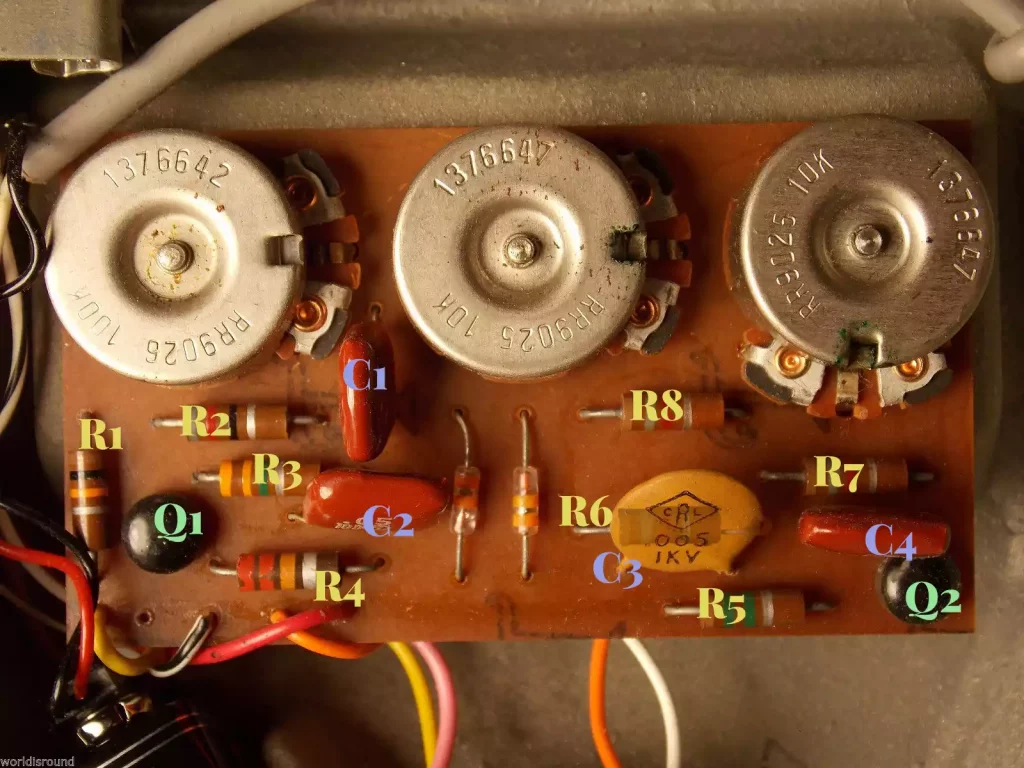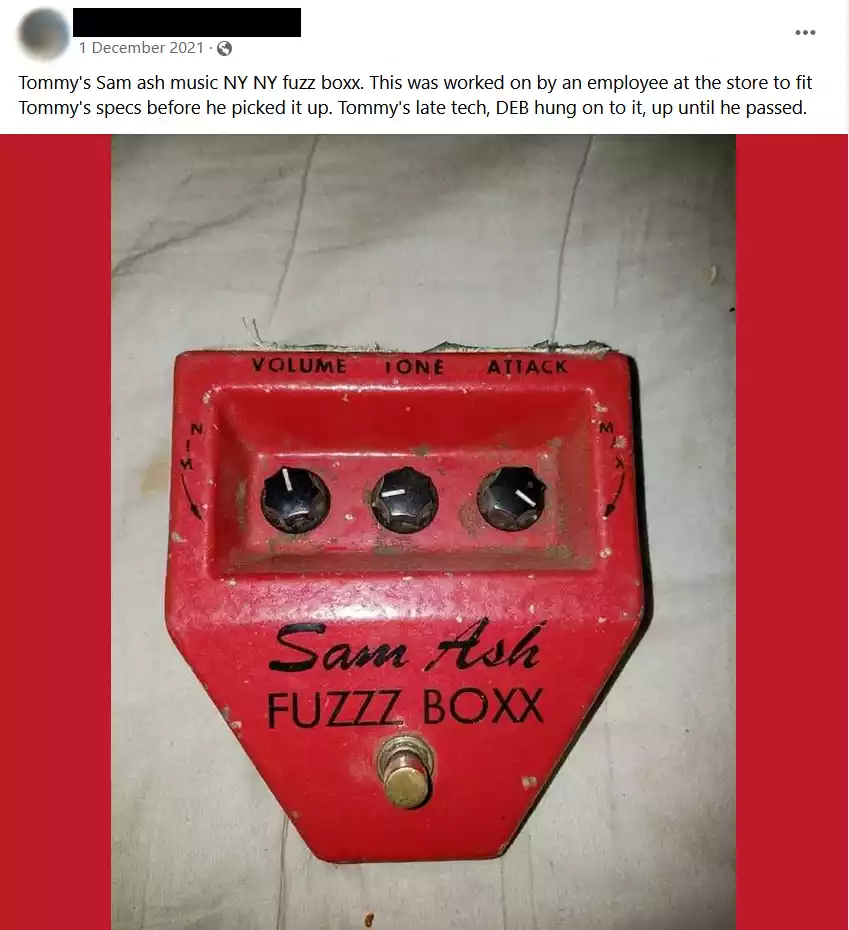- Introduction
- Version 1
- Version 2
- Astrotone
- Fuzzz Boxx
- Alternative Fuzzz Boxx
- Sam Ash ‘Ashtrotone’ Fuzzz Boxx
- Late Fuzzz Boxxes
- SM07027 transistors
- MPS6552 transistors
- Final notes
- Share your fuzz!
Introduction
Universal Amplifier Corp. was a mysterious company that manufactured the Astro Amp series of guitar amps and fuzz boxes during the late 1960s. According to the business address listed on Astro Amp literature, the company was based at 615 West 131st Street in New York City (known as the Studebaker Building, now part of the Columbia University campus). During the 1960s, the premises here were used for a number of different purposes, including numerous small manufacturing firms.1
The black Astro Amp Astrotone pedals were seemingly built in reasonable numbers. The earliest known examples date to 1967, and date codes from surviving pedals prove that the model was still in production by 1969. By far the most well-known product built by Universal Amplifier was the rebranded fuzz box that was supplied to New York’s chain of Sam Ash music shops: the Sam Ash Fuzzz Boxx. With identical circuitry as the Astrotone, the Fuzzz Boxx came in a much more eye-grabbing bright red colour scheme.
For a certain period of time, it appears that Sam Ash-branded Fuzzz Boxx pedals were being built alongside the black Astrotone pedals. For the purposes of clarity, unless it is otherwise specified, the terms ‘Fuzzz Boxx’ and ‘Astrotone’ are used interchangeably in this article to describe both the red and the black American three-knob pedals.
A schematic for the basic Astrotone pedal and an annotated layout are displayed below. These will be referenced over the course of the technical discussion in this article. The findings in this article come from the analysis of photos of 40 surviving Fuzzz Boxx/Astrotone pedals. As and when more pedals resurface, and new discoveries are made, the page will continue to be updated.
The Astrotone is an interesting circuit in the wider history of guitar effects pedals, because it is to this date the earliest known distortion circuit that uses clipping diodes. This is a technology that would go on to become incredibly widespread as musicians’ interests moved away from crude fuzz sounds, and towards softer ‘overdriven’ sounds instead.
This article focuses on the smaller details of how the Astrotone and Fuzzz Boxx pedals gradually evolved over course of production, and will hopefully serve as a useful resource for guitarists to compare their own vintage pedals (and replicas) against.
Version 1

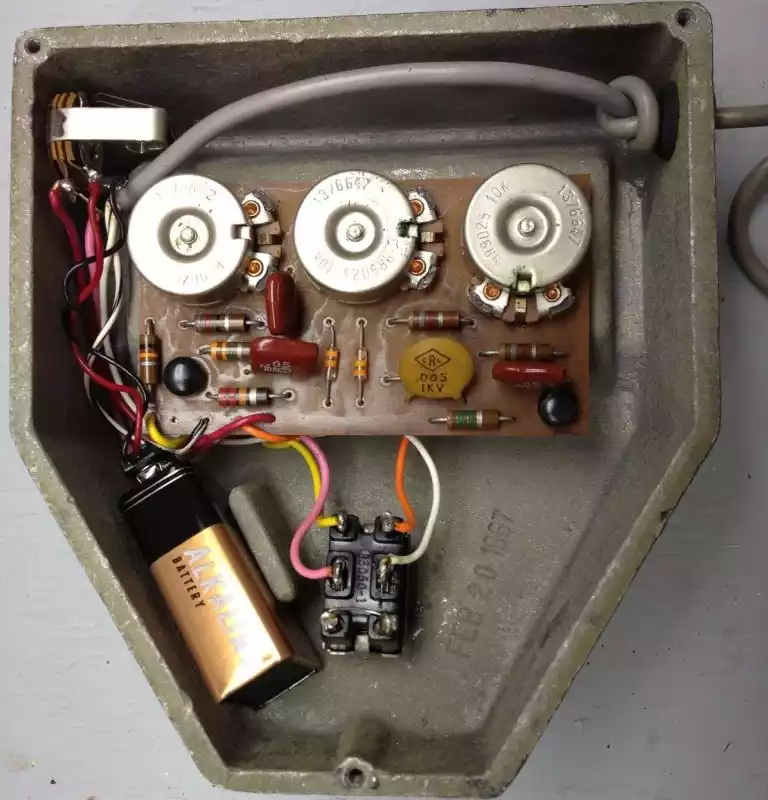
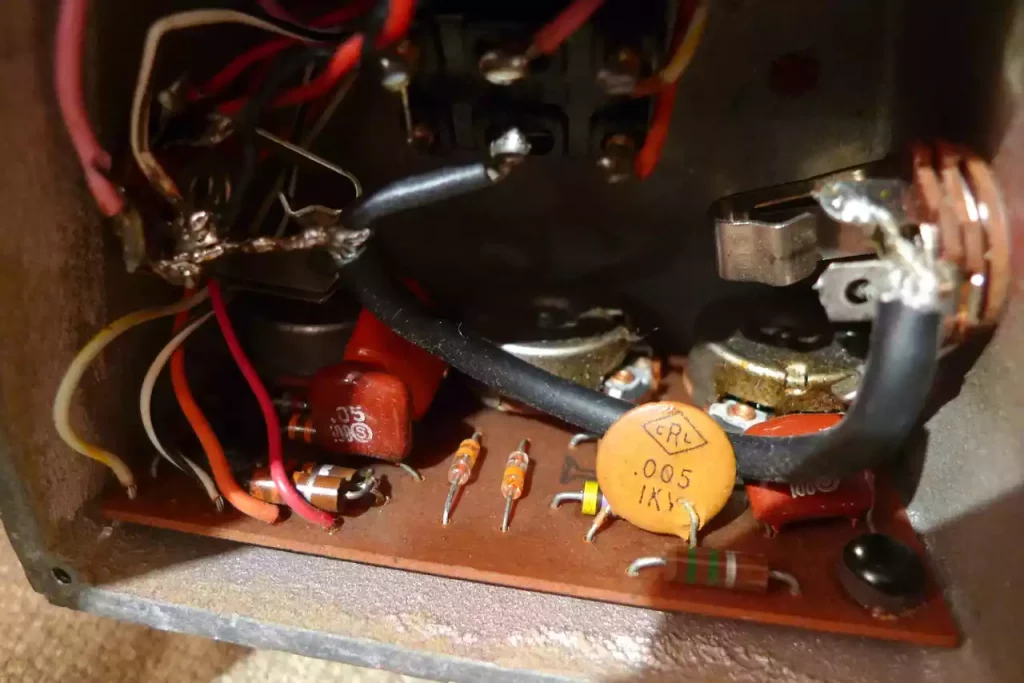
The earliest Astrotone and Sam Ash Fuzzz Boxx pedals used identical printed circuit boards, and an identical mixture of components. This includes the pair of Fairchild 2N3565 transistors that would go on to be used for the first few revisions of this model. Both the Astrotones and the Sam Ash Fuzzz Boxxes built during this period were also fitted with hardwired output cables, and a sheet of ribbed rubber mat was fitted underneath the pedals to prevent them from slipping around on-stage. (Photo credit: worldisround/eBay.com, Southside Guitars)
Early Astrotone pedals were stamped inside with production (or inspection) dates, but these earliest Sam Ash pedals apparently weren’t. The single known surviving Astrotone with this mixture of parts has a date of February 1967, and the fact that undated early Sam Ash pedals feature identical parts suggests they were also built during this approximate period. The CTS potentiometers in these pedals typically date to the 47th week of 1966, which is also to be expected for a pedal built in early 1967.
This early circuit has a handful of notable differences, however, to the more commonly-seen models that followed.
- R1 and R2 in the earliest Astrotone/Fuzzz Boxx schematic are exclusive to this early version of the design. A 10kΩ resistor, used in the R1 position, limits the signal at the input of the fuzz circuit. R2 is an 82Ω resistor, placed after the -9v power supply. The way that R2 sits in between the clipping diodes & attack potentiometer, and ground, may contribute to a slightly softened distortion effect.
- R4 on these early circuit boards typically uses a 22kΩ resistor, which is a feature that continued over the course of several years in these pedals, but some of these very earliest Fuzzz Boxxes have been seen fitted with a pair of ‘piggybacked’ 33kΩ resistors in that position.
- This early Astrotone circuit uses a 5nF ceramic capacitor for C3 (after the clipping diodes) alongside the three red 50nF film capacitors. Later revisions used 50nF capacitors for C3 instead.
Version 2
Astrotone

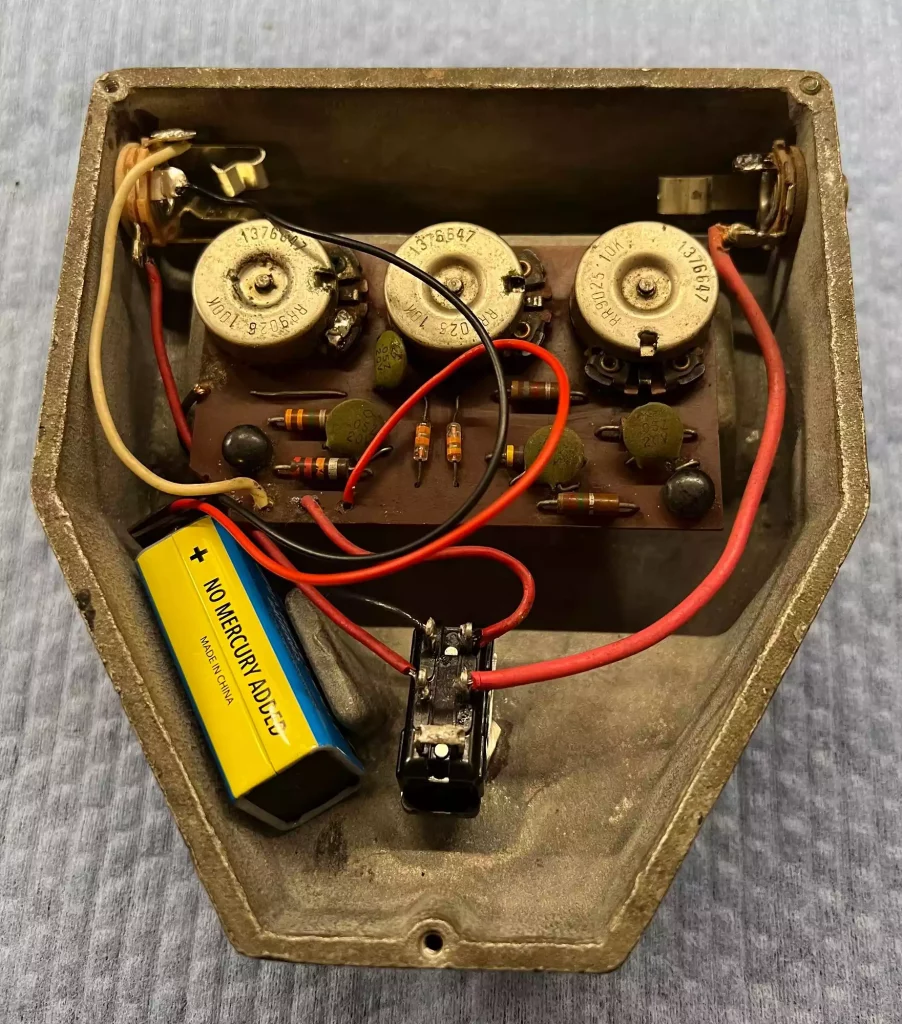
The 10kΩ and 82Ω resistors in R1 and R2 positions appear to have been a short-lived feature in the Astrotone/Fuzzz Boxx pedals. The pedal pictured above has been built with the most commonly-sighted set of electronics for a black Astrotone pedal in particular. Using the same printed circuit boards as the early version, the manufacturers elected to use a jumper wire to bridge the vacant R2 position, and to move the input wire further along the PCB to bypass the obsolete break for R1. (Photo credit: S. McPherson)
Changes that were made to the Astrotone circuit at this point included:
- C3 was increased to 50nF. The decision to do so may have come purely out of the convenience of having all four capacitors in the circuit be the same type and value, because it is uncertain at this point what kind of effect this change would have on the sound of the fuzz.
- Green ceramic capacitors were used on these boards instead of the earlier red film capacitors.
- The resistor in R5 was reduced from 1.5MΩ to 1.2MΩ.
- In some exemplars, the 3.3MΩ resistor for R3 was split with a second ‘piggybacked’ 3.3MΩ, bringing the overall resistance closer to 1.7MΩ.
This version of the Astrotone (with the bypassed resistor tracks and the green ceramic capacitors) typically featured date stamps inside the casings, placing them to March 1967. Some of the Astrotone/Fuzzz Boxx pedals with this mixture of parts, however, were also undated. Like the earliest Astrotones, these second version pedals typically also feature late 1966 date codes on the potentiometers, and because the earliest Astrotone (with the extra resistors) was stamped February 1967, we can be quite confident that these weren’t built prior to that year.
Fuzzz Boxx

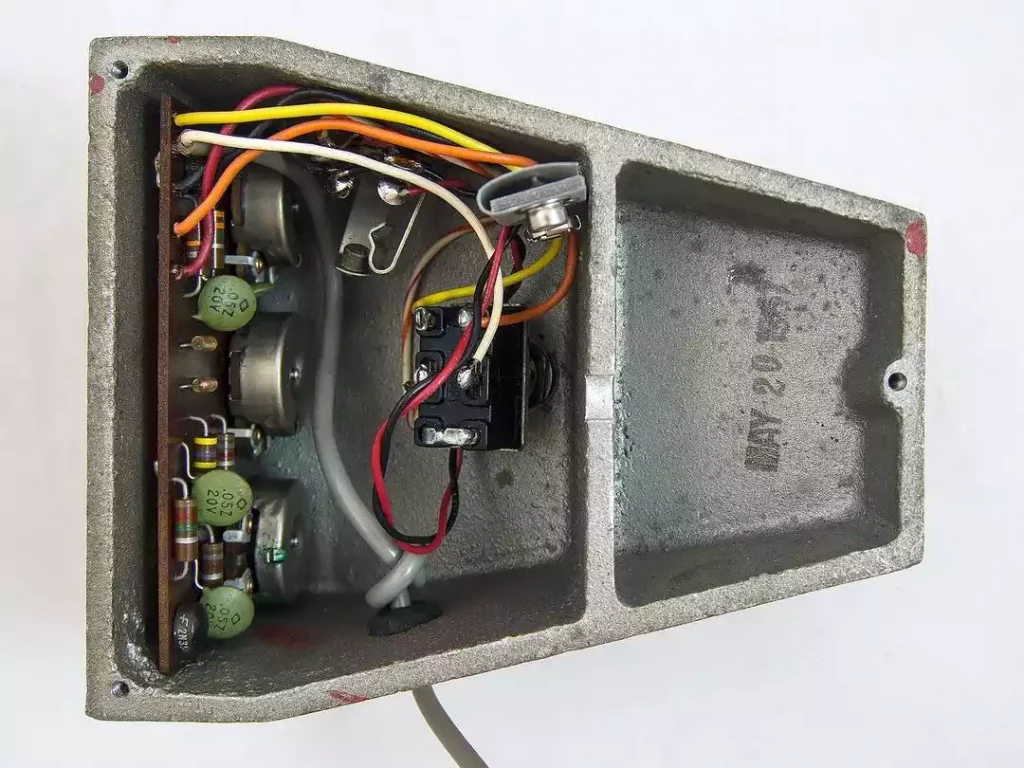
Sam Ash Fuzzz Boxx pedals were also built with the ‘version 2’ circuit and mixture of parts (including the green ceramic 50nF capacitors). These pedals have been sighted with May 20th and May 22nd 1967 date stamps inside. By the time that these Sam Ash pedals were made, the printed circuit boards had also been updated to reflect the omitted input and ground resistors, and so it isn’t surprising to see a jump of several months between the Fuzzz Boxx above, and the Astrotones that date to March. On these Fuzzz Boxxes, with the green ceramic capacitors and updated PCB design, there was no longer the need to use jumper wires to bridge tracks, nor to move the circuit’s input wire from its original position on the board. (Photo credit: A. Souleyman)
Features like the hardwired output cable continued to appear on the pedals built during this period.
Alternate Fuzzz Boxx
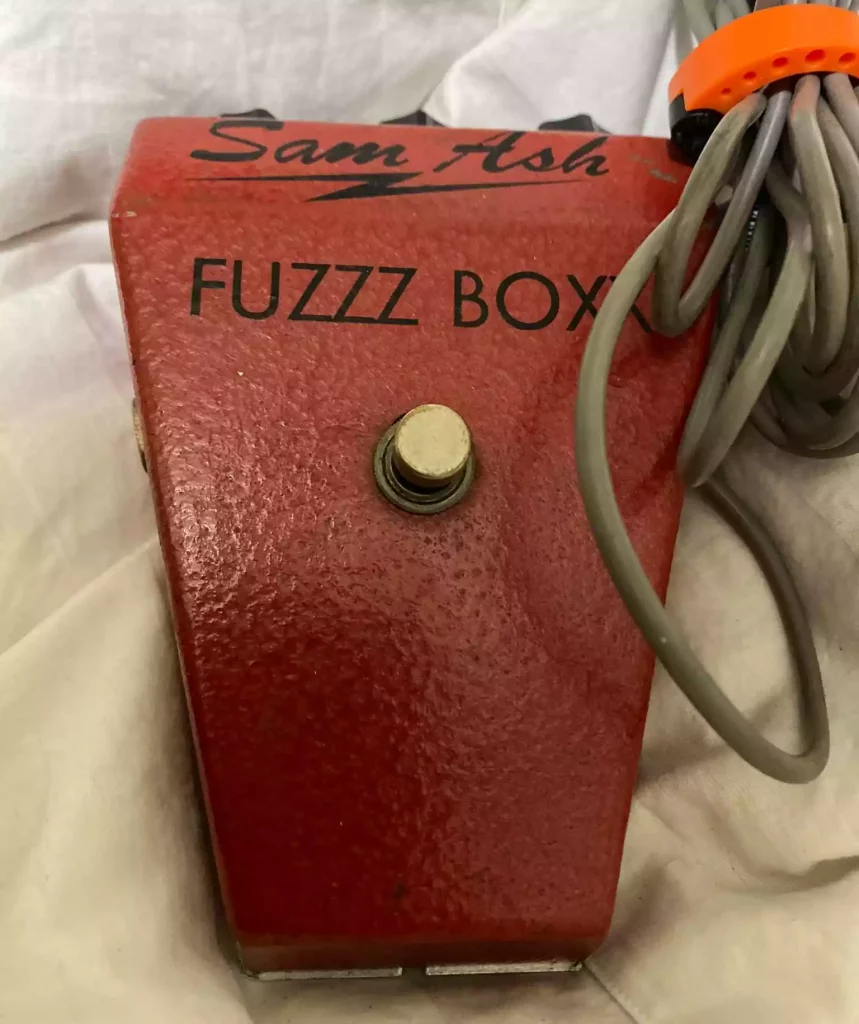
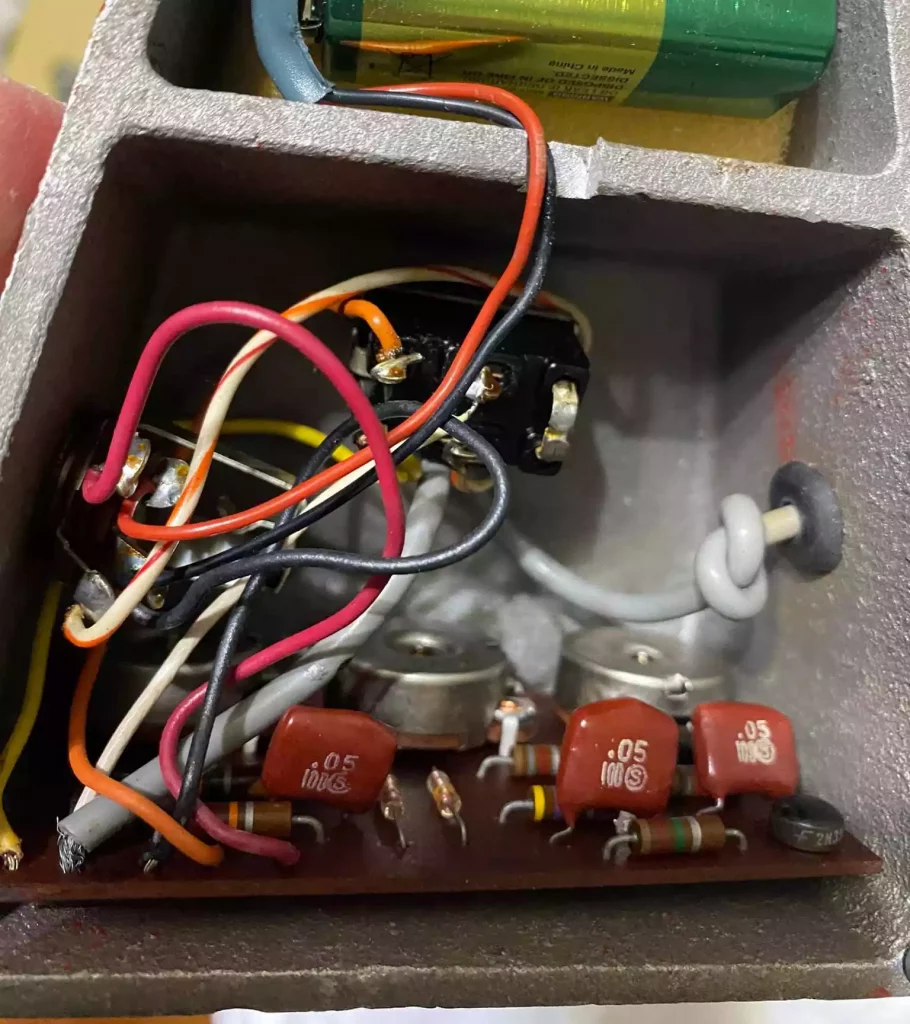
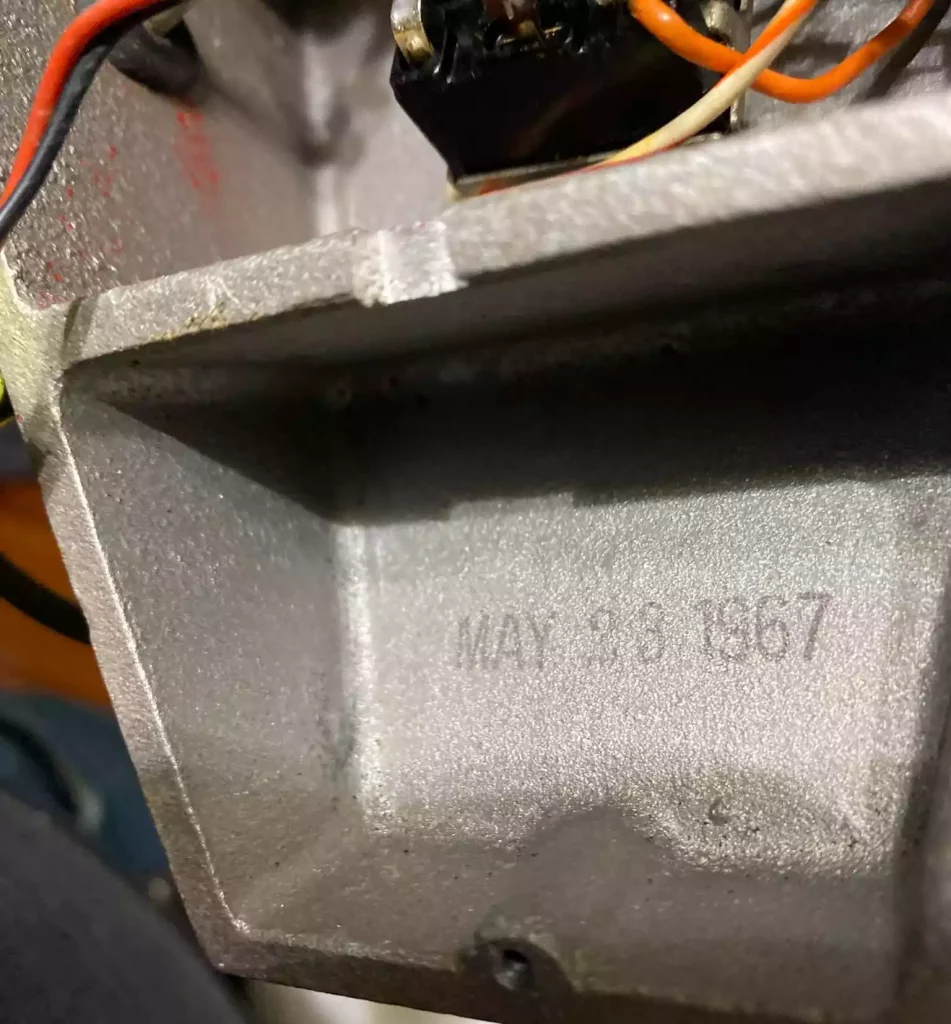
At this point in the chronology, things already start to become murky. Pictured above is a version of the Fuzzz Boxx that features the conventional ‘version 2’ circuit (i.e. omitting R1 and R2), but at the same time, it also uses four of the early type of 50nF red film capacitors (as seen in C1, C2 and C4 positions of the first Astrotone). This version of the Sam Ash pedal has also been built on the updated printed circuit board, where there was no need to bypass the tracks for the omitted resistors. (Photo credit: P. Holt)
Ordinarily one might see this and assume it to be a sort of transitional Fuzzz Boxx — the same type/brand of capacitors as the earliest Astrotone, but with the slightly later adjustments to the schematic. The reason this Fuzzz Boxx is confusing is because several examples like it have been seen with 23rd May 1967 date stamps inside.
The date stamp suggests that these were built after the ‘version 2’ Astrotones with the March 1967 stamps, despite featuring a parts selection more closely aligned with the apparently earliest ‘version 1’ known unit with the February stamp.
Sam Ash ‘Ashstrotones’
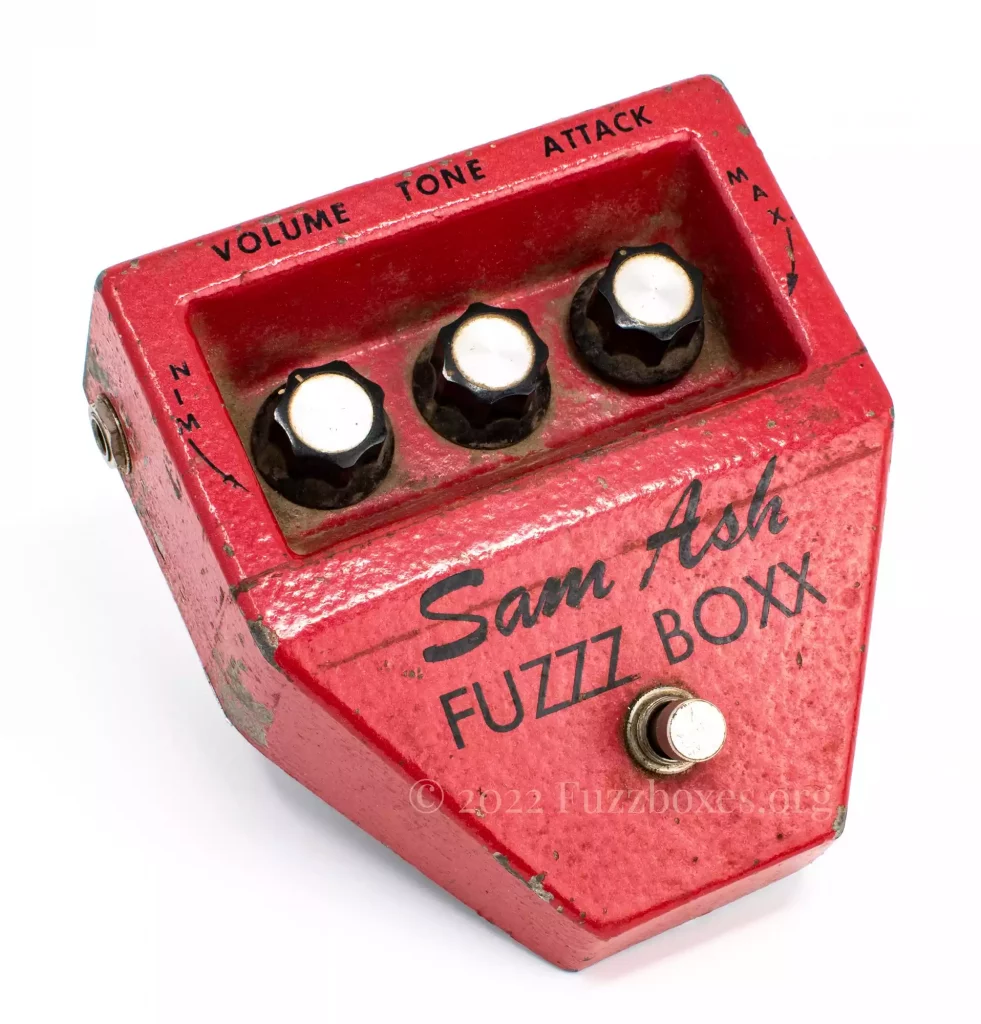
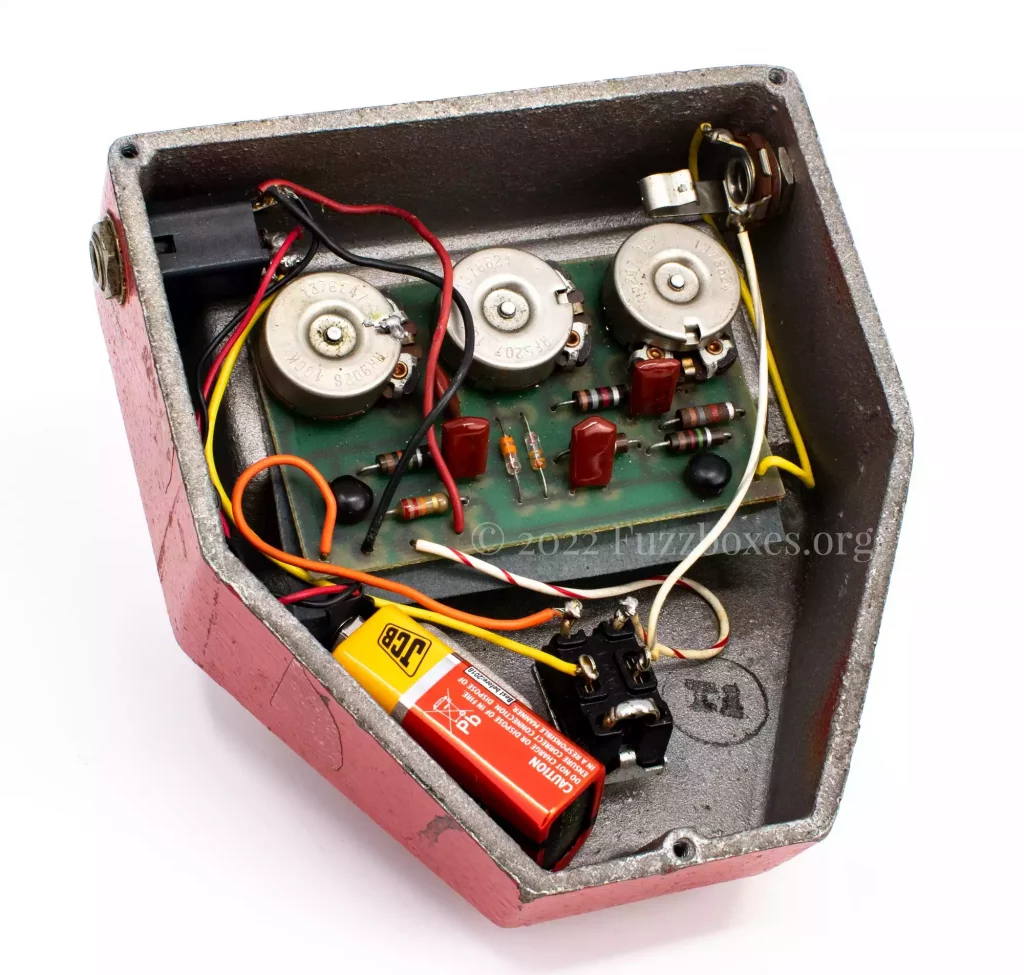
The Sam Ash Fuzzz Boxx pictured above was initially believed to have been a particularly early version of the Sam Ash-branded model, due to it having been built in the same type of enclosure as the black Astrotones. However, there are significant details in the small handful of these Sam Ash ‘Ashstrotones’ that are actually consistent with a later build.
The obvious difference in the construction of the pedal pictured above, compared with the others pictured earlier on this page, is the use of a green printed circuit board instead of the brown paper phenolic material. The parts layout on the board is also consistent with the ‘later’ Fuzzz Boxx circuit, omitting any signs of resistors R1 and R2 having ever been part of the pedal’s design. By the time that Fuzzz Boxxes were being built into these ‘Ashstrotone’ enclosures, the fitting of a hardwired output cable was also abandoned, and a standard jack socket was used for the pedal’s output instead.
Despite the new PCB material, the selection of parts for the red ‘Ashtrotones’ was for the most part still the same as the earlier black Astrotone and wedge-shaped Fuzzz Boxx pedals, including the use of Fairchild 2N3565 transistors. There are, however, two areas on the PCBs where the selection of resistors differs.
- This type of Fuzzz Boxx has sometimes been sighted with fawn 22kΩ resistors in R4, instead of the brown carbon composite resistors.
- A choice of either 1.2MΩ or 1.3MΩ resistors were used in the R3 position, instead of the (sometimes ‘piggybacked’) 3.3MΩ resistors.
Unlike many of the earlier Astrotones and Fuzzz Boxxes, the known surviving red ‘Ashstrotone’ pedals sadly don’t have any visible date stamps inside. The date codes on the potentiometers in this version aren’t helpful either in ascertaining when the model was built, because many of this type of Fuzzz Boxx feature potentiometers with earlier date codes than even the very earliest known Astrotone. The omission of R1 and R2, along with the hardwired cable, as well as the use of the green PCB (within the wider context of the Astrotone’s development) are all strong indicators that these ‘Ashstrotone’ pedals were built at a later point than the wedge-shaped Sam Ash pedals with the brown PCBs.
Possibly the most well-known user of the Fuzzz Boxx, Tommy Bolin, supposedly used a pedal in this type of enclosure. The photo above was taken of one of Bolin’s actual Fuzzz Boxxes, during a time when the pedal belonged to his former tech, David Earl Brown. It is rumoured that this pedal was modified for Bolin at the Sam Ash store, but details of the circuitry inside are sadly unknown, and following Brown’s death, as are the pedal’s current whereabouts.
Late Fuzzz Boxxes
SM07027 transistors

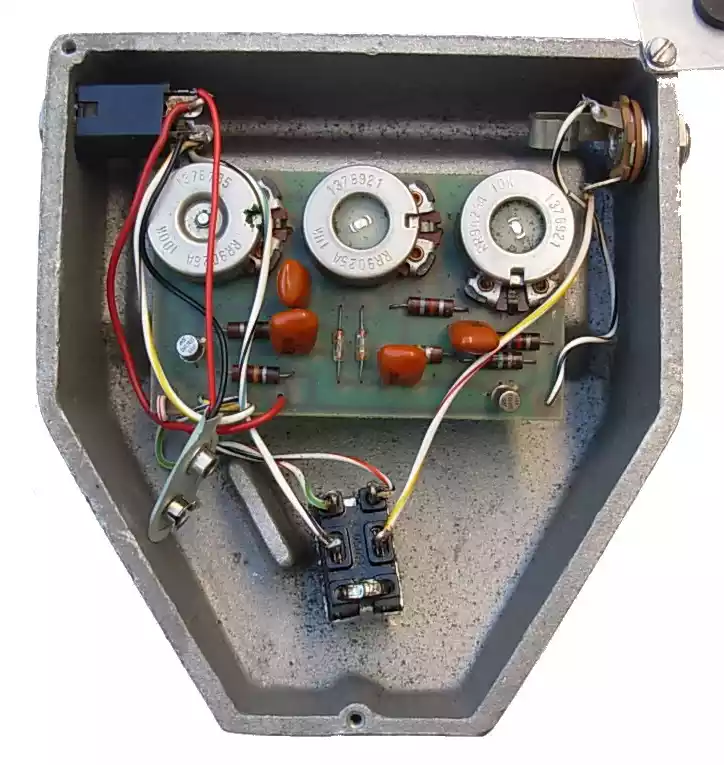
Late-production Fuzzz Boxxes have been sighted with two different transistor setups. Some, like the pedal pictured above, featured metal can National Semiconductor ‘SM07027’ transistors. This particular circuit board has been built into a black Astrotone enclosure, and the date codes on the pots and transistors reveal that it wasn’t built before 1969. (Photo credit: C. Nelson)

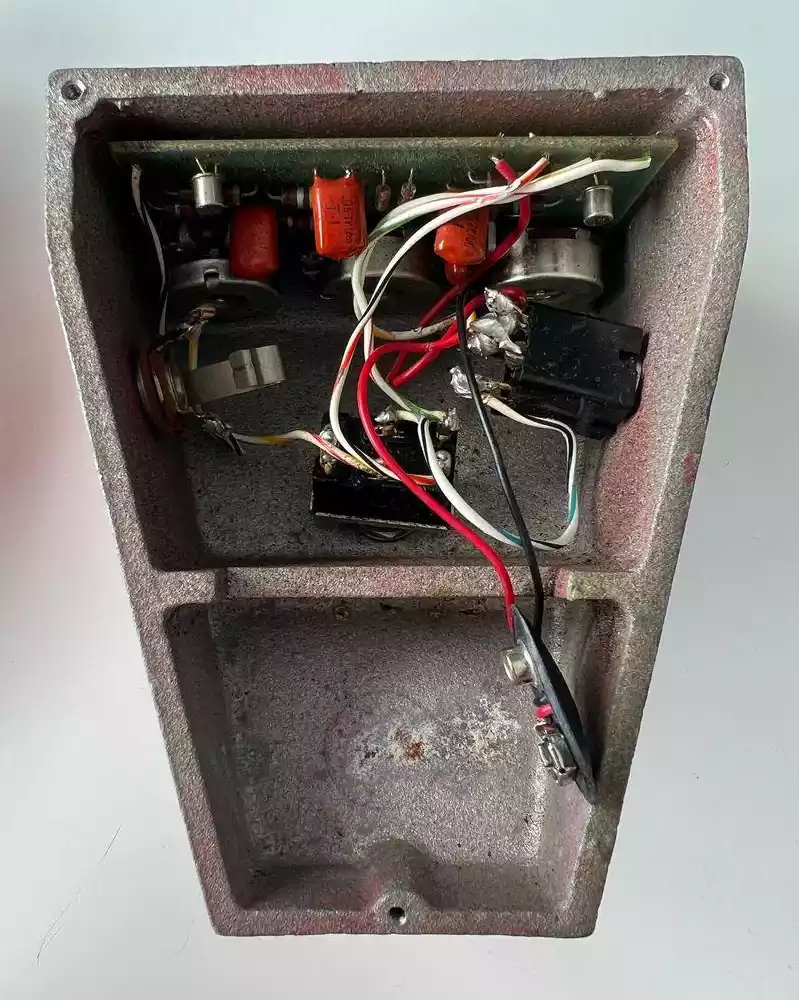
Red wedge-shaped Sam Ash pedals were also built using the same set of electronics. It was at around this time that the ribbed rubber mats on the bottom plates of the Astrotones and Fuzzz Boxxes were updated to a set of three rubber bumpers. (Photo credit: J. Scott)
Fuzzz Boxxes with these mysterious ‘SM07027’ transistors feature both 22kΩ and 220kΩ resistors in the R4 position. Compared with the 2N3565 Fuzzz Boxxes, this version also uses 1MΩ resistors in the R3 and R5 positions.
MPS6552 transistors
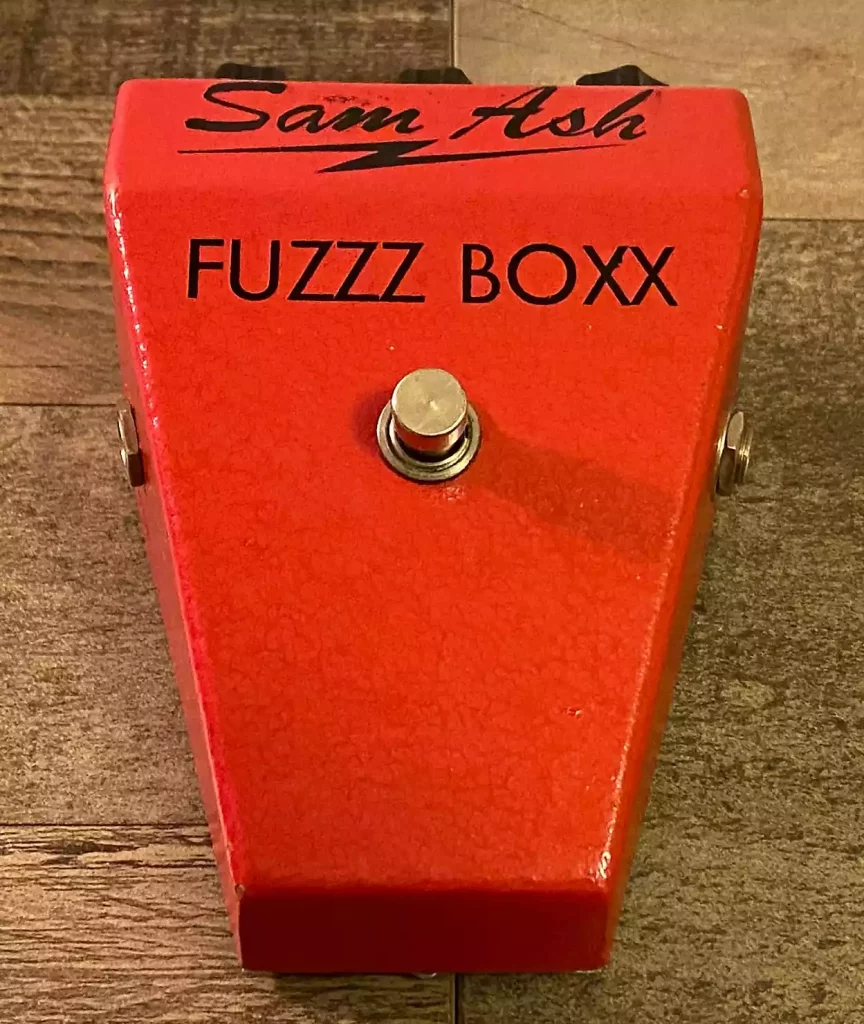
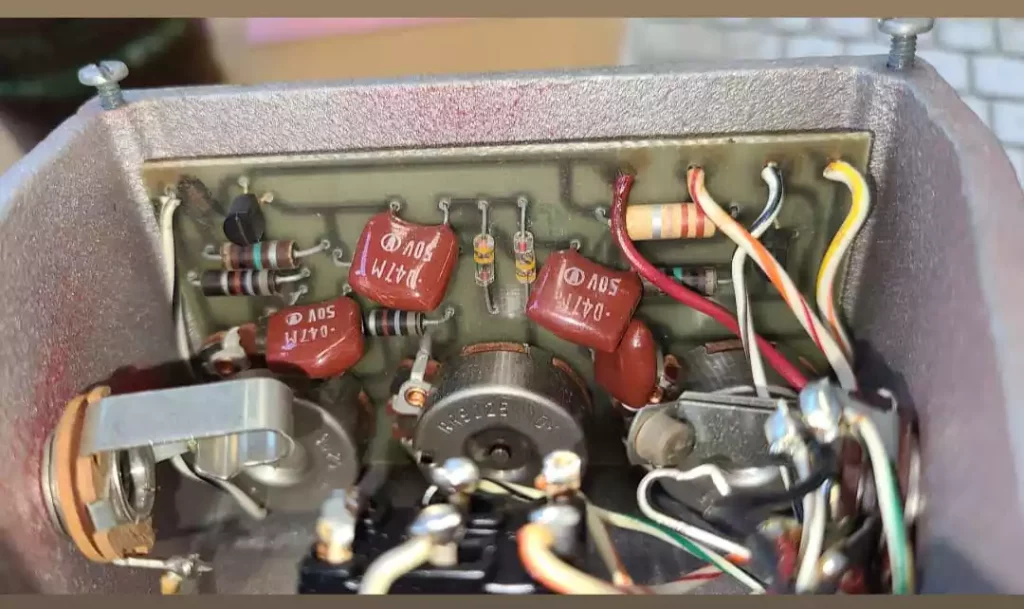
Other late Fuzzz Boxxes came with TO-92 package MPS6552 transistors, and like those with the metal can transistors, these Fuzzz Boxxes also appeared with either 22kΩ or 220kΩ resistors in R4, along with the same 1MΩ resistors for R3 and R5. (Photo credit: Odd’s End Gearhouse/Reverb.com & D. Danger)
It isn’t known which of these two late versions of the Fuzzz Boxx came first, or perhaps whether they were made concurrently at different workstations. The use of the green printed circuit boards, along with the ‘1969’ date codes sighted on the volume and tone potentiometers, solidify their position towards the end of production.
Final notes
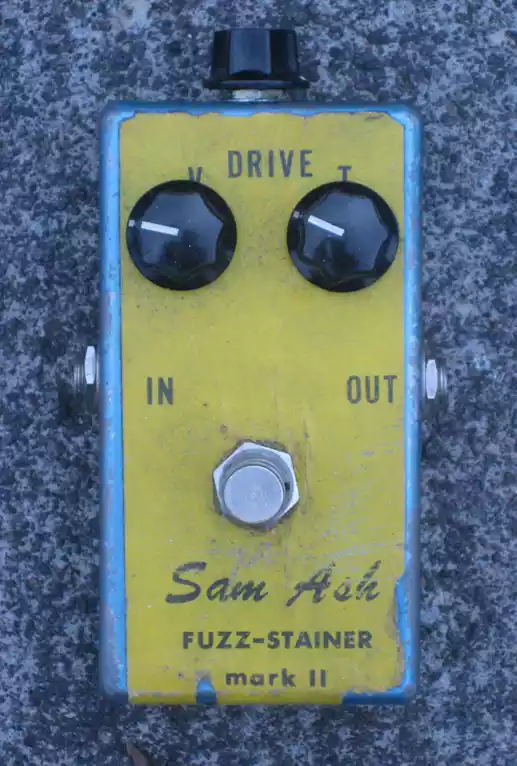
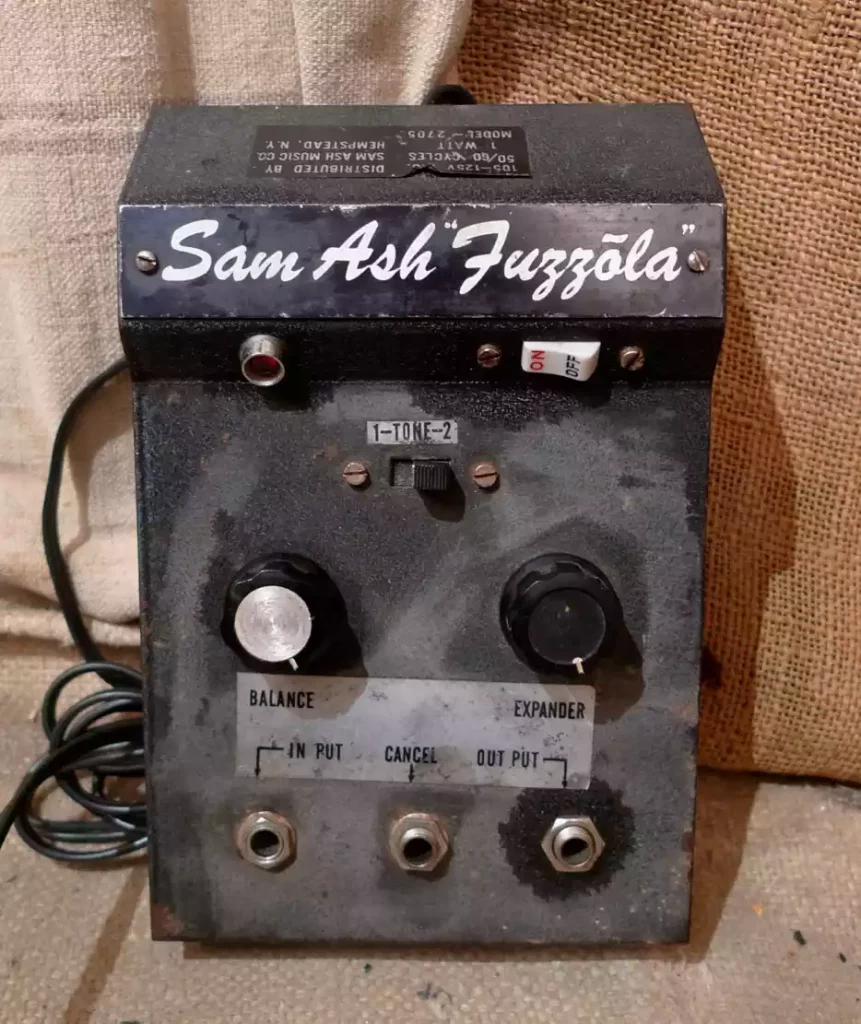

The Sam Ash Fuzzz Boxx was one of the more mass-produced pedals available during the 1960s, and the original examples are still relatively easy to source on the vintage market nowadays. At some point in the late 1960s (or early 1970s), for whatever reason, production of the Fuzzz Boxx ceased. Nevertheless, Sam Ash went on to sell other fuzz pedals under their name during the 1970s, including the enigmatic ‘Fuzz-Stainer’, and the Fuzzola pedals (built initially by Shin-ei in Japan, and later by Jen in Italy). (Photo credits: M. Wright, Southside Guitars, unknown)
A reissue of the original Fuzzz Boxx was introduced by Sam Ash in the year 2013.
The fate of Universal Amplifier Corp. and its various ‘Astro Amp’ products is sadly unknown, and I would be very grateful to hear from anybody with any further information about this company and the people involved.
Share your fuzz!
I welcome any comments, feedback, queries & corrections in relation to the Fuzzboxes.org project. Please get in touch via this contact form (or on the ‘contact‘ page).
The technical analysis of Astrotone and Fuzzz Boxx pedals comes as a direct result of having an extensive database of photos for reference. Nevertheless, there is still much to learn about the origins of these early overdrive pedals, and any readers’ contributions of information and/or photos of vintage pedals are greatly appreciated.
I’m also searching for an old black Astrotone pedal for my own collection of fuzz boxes, so if any reader happens to be sitting on one of these pedals, and might be daft enough to consider selling it, then please do get in touch.
Thanks to Ed Skymall, Josh Scott and Johannes Voggenthaler for their enthusiasm, and for collecting & contributing Astrotone photos over the years.
